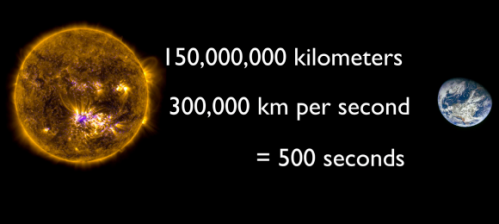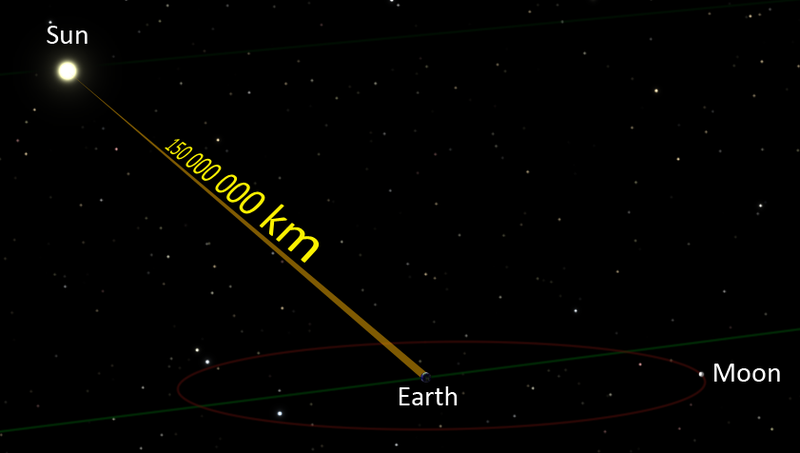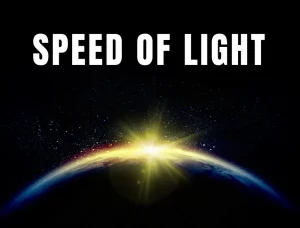Introduction
The speed of light is one of the most fundamental and intriguing phenomena in physics, playing a central role in our understanding of the universe. Defined as the speed at which electromagnetic radiation propagates in a vacuum, the speed of light is a constant that has been precisely measured and studied in detail. It has important implications for a wide range of fields, from telecommunications to astrophysics, and continues to be the subject of ongoing research and development. In this blog post, we will explore the key aspects of the speed of light, including its properties, measurement, applications, and related theories and phenomena.
1 Light Speed = 2,99,792 Kilometer Per Second


Definition of the Speed of Light
The speed of light is a fundamental constant of nature, representing the fastest speed at which electromagnetic radiation can travel through a vacuum. It has a value of 299,792,458 meters per second (m/s).
Importance of the Speed of Light
The speed of light is one of the most important physical constants, playing a crucial role in various areas of science and technology, including physics, astronomy, and communication. It provides a fundamental limit to the speed at which information can be transmitted and helps to define our understanding of space and time.
Brief History of the Discovery of the Speed of Light
The speed of light was first measured in the mid-17th century by the Dutch astronomer, Christiaan Huygens. Over the next few centuries, numerous scientists and researchers conducted experiments to refine the measurement of the speed of light. By the late 19th and early 20th centuries, the speed of light was widely accepted as a fundamental constant of nature. Today, scientists continue to study the properties and behavior of light, leading to new breakthroughs and applications in a variety of fields.
Properties of the Speed of Light
The speed of light is a constant that plays a central role in physics and our understanding of the universe. However, it also exhibits unique properties that distinguish it from other physical constants. In this section of the blog post, we will explore the properties of the speed of light, including its constancy, universality, and theoretical limits. We will discuss how these properties have been established through both theoretical and experimental work, and their implications for our understanding of the nature of light and the universe.
The constancy of the Speed of Light
The speed of light is considered to be a constant of nature, meaning that it is the same in all inertial frames of reference and does not change with time or position. This property is central to our understanding of the behavior of light and the laws of physics.
The universality of the Speed of Light
The universality of the speed of light means that it is the same for all observers, regardless of their relative motion. This property is a fundamental aspect of Einstein’s theory of special relativity, which fundamentally changed our understanding of space and time.
Theoretical Limits of the Speed of Light
The speed of light is widely considered to be an absolute speed limit in the universe, meaning that nothing can travel faster than light. This has important implications for our understanding of the universe and the nature of matter and energy. Some theories, such as those related to black holes and wormholes, suggest the possibility of faster-than-light travel, but these ideas are still the subject of ongoing research and debate.
Measurement of the Speed of Light
The speed of light is a constant that has been precisely measured and studied for centuries. Accurate measurements of the speed of light have been crucial for the development of modern physics and technology. In this section of the blog post, we will explore the history of the measurement of the speed of light, from early experiments to modern techniques, and the accuracy and precision of these measurements. We will also discuss how advances in measurement techniques have led to a deeper understanding of the nature of light and its role in the universe.
Early Experiments to Measure the Speed of Light
The first attempts to measure the speed of light were performed in the mid-17th century by the Dutch astronomer, Christiaan Huygens, and the French mathematician, Gilles Personne de Roberval. These early experiments used simple methods, such as timing the travel time of light between two mirrors, to estimate the speed of light.
Modern Techniques for Measuring the Speed of Light
Today, the speed of light is measured using a variety of sophisticated techniques, including laser interferometry, frequency-domain methods, and the use of frequency combs. These methods allow for much more precise measurements of the speed of light, with uncertainties of less than 1 part in a billion.
Accuracy and Precision of Measurements
The accuracy and precision of modern measurements of the speed of light are continuously improving, due to advances in technology and experimental techniques. Currently, the speed of light is known to a high degree of precision, with an uncertainty of only a few parts in a trillion. This high level of accuracy is important for a wide range of applications, including telecommunications, navigation, and the development of new technologies.
Applications of the Speed of Light
The speed of light is a fundamental constant that plays a crucial role in a wide range of applications and technologies. In this section of the blog post, we will explore some of the most important applications of the speed of light, including optical communications, astronomy and astrophysics, and medical imaging. We will discuss how these applications rely on the unique properties of light and the speed at which it travels, and the impact that they have on our daily lives and our understanding of the universe.
Optical Communications
The speed of light plays a crucial role in optical communications, allowing for the transmission of the information at high speeds over large distances. This technology is used in a wide range of applications, including fiber optic networks, laser communication systems, and satellite communications.
Astronomy and Astrophysics
In astronomy and astrophysics, the speed of light is used to study the behavior of light and the properties of distant celestial objects. This includes determining the distance to stars and galaxies, studying the behavior of black holes, and understanding the origins of the universe.
Medical Imaging
In medical imaging, the speed of light is used to create images of the human body and study the structure and function of tissues and organs. This includes technologies such as X-rays, CT scans, and MRI. These images provide valuable information that is used to diagnose and treat a wide range of medical conditions.
Theories and Phenomena Related to the Speed of Light
The speed of light is a phenomenon that has captivated scientists and researchers for centuries, and has led to the development of numerous theories and concepts related to the nature of light and the universe. In this section of the blog post, we will explore some of the most important theories and phenomena related to the speed of light, including special relativity and time dilation, the twin paradox, and gravitational lensing. We will discuss how these concepts are linked to the speed of light and have important implications for our understanding of the universe and its fundamental laws.
Special Relativity and Time Dilation
The speed of light plays a central role in Einstein’s theory of special relativity, which describes how the laws of physics are the same for all observers, regardless of their relative motion. According to this theory, as an object approaches the speed of light, time slows down, a phenomenon known as time dilation.
The Twin Paradox
The twin paradox is a thought experiment that illustrates the effects of time dilation. In this experiment, one twin travels at high speed, while the other remains at rest. Upon their return, the twin who traveled at high speed will have aged less than the twin who remained at rest, due to the effects of time dilation.
Gravitational Lensing
Gravitational lensing is a phenomenon in which the path of light is bent by the gravitational field of a massive object, such as a galaxy or a cluster of galaxies. This results in a distorted image of the object behind the lens, and can provide important information about the distribution of matter in the universe.
Future Research and Development
Despite centuries of research and experimentation, the speed of light remains an area of ongoing study and development. In this section of the blog post, we will explore the future of research and development related to the speed of light, including improving the precision of measurements, understanding the nature of light and the speed of light, and developing new technologies that utilize the speed of light. We will discuss the potential impact of these developments on fields such as telecommunications, astronomy, and quantum computing, and the opportunities and challenges that lie ahead.
Improving the Precision of Measurements
In the future, researchers will continue to work on improving the precision of measurements of the speed of light. This will be achieved through the development of new experimental techniques, as well as advances in the accuracy of clocks and other timekeeping devices.
Understanding the Nature of Light and the Speed of Light
The study of the nature of light and the speed of light will continue to be a major area of research, with the goal of gaining a deeper understanding of these phenomena and their role in the universe. This will likely involve a combination of theoretical and experimental work, and may lead to new discoveries about the properties of light and its behavior in extreme conditions.
Developing New Technologies that Utilize the Speed of Light
The speed of light will continue to play a crucial role in the development of new technologies, including advances in telecommunications, navigation, and medical imaging. Researchers will also explore the use of light for new applications, such as ultra-fast computing and quantum information processing.
Conclusion
The speed of light is a fundamental constant that plays a crucial role in physics and technology. It is a universal constant that exhibits unique properties, has been precisely measured and studied, and has important applications in fields such as telecommunications, astronomy, and medical imaging. It is also linked to important theories and phenomena and continues to be the subject of ongoing research and development.
Summary of Key Points
In this blog post, we have explored the speed of light, including its definition, importance, discovery, properties, measurement, applications, and related theories and phenomena. We have also discussed future research and development in this field.
Reflection on the Significance of the Speed of Light
The speed of light is one of the most fundamental and fascinating aspects of our universe, playing a central role in many areas of science and technology. It is a constant that has been precisely measured, and its properties have been studied in detail. The speed of light is not only a scientific concept but also a symbol of our continued pursuit of knowledge and understanding.
Final Thoughts and Future Implications
The study of the speed of light will continue to be an important area of research, with implications for a wide range of fields and technologies. As our understanding of this phenomenon evolves, it will continue to shape our view of the universe and inform the development of new technologies that will impact our daily lives.

